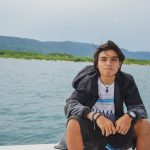It’s another day onboard during our manta safari. But today something unusual happened. As we were preparing for our morning dive, the crew discovered a major problem with the boat engine. It is new moon at the moment, meaning the tides and currents are very strong. Without a fully functioning engine, it’s not safe for us to try to make our journey until a spare part arrives from Labuan Bajo.
We were planning to visit Manta Point today. This is one of the most popular sites in Komodo National Park to see manta rays. Instead we are stuck at Padar Island for the whole day. We were disappointed, but nothing we can do and so the plan was changed.
Andy called us and we began to discuss about the moon, the tides, the currents and how they affect the manta rays. That was how we began a basic basic oceanography class.
There is a unique condition that happens in the waters around Komodo National Park. To the north the oceans are oligotrophic – almost like a desert they a nutrient-limited. The warm seas and bright sunlight promote high rates of photosynthesis and biological growth that quickly use up any nutrients that are available.
In contrast the seas to the south of Komodo are eutrophic and high in nutrients. Upwelling along the steep coastal shelf brings cold, nutrient rich water up from the ocean depths.
In this location, when the tides rises currents flow to the north, and when the tide falls they flow south. This means that the rising tide carries cooler, nutrient rich water into Komodo National Park.
This nutrient-rich water supports phytoplankton populations to grow, which in turn support blooms of zooplankton. This is the perfect food for manta rays, and so we predicted that rising tide would be a good time to find mantas at Manta Point.
I should tell you that there are also more factors that affect the appearance of manta rays in Komodo National Park. We’ve learned that September-October is Manta Month – it’s mating season in Komodo National Park! Mantas come from all around to breed. Manta mating is one of the rarest things to see when encountering manta rays.
As we continued discussing with Andy, we realised that oceanography is actually very fun and an important consideration when we plan our manta surveys. I realised that as marine scientists we must learn not only about the hidrobiology but also about the oceanography. The ocean processes affect the marine life within it, so hidrobiology and oceanography cannot be separated.
If you’re a student studying marine science, be surety pay attention to your oceanography lecturer! But if you still find it difficult to understand what they are teaching, check out these videos which I found really useful.


